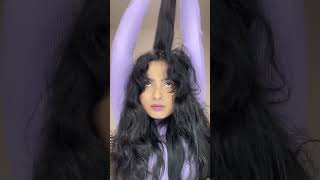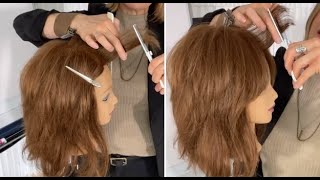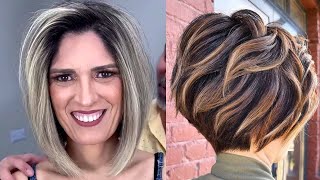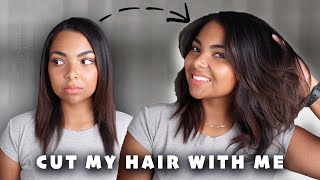Layered Haircut Tutorial With Bangs For Long Hair
- Posted on 06 November, 2021
- Long Hair
- By Anonymous
How to cut a Bangs Haircut for long hair
Sharing great cutting techniques and tips.
Learn how to cut best hair. The best haircut tutorial
"I Love Haircut - I Love Hairstylist"
Today, we're going to do a little simple face frame, keeping the length throughout the bottom, just bringing this up a little bit and connecting it to her longest piece. Someone named uh, craysteve xo says: that's my bestie, hey, hey chelsea! Am i saying that weird christies her last name is stevie? Okay, so we're holding it at about 45 degrees? Here it looks like yes, i'm gon na come in. Take my razor. You can see dylan's working above his fingers with the razor. That'S a big difference of you know, using a razor and using a scissor when you're using a scissor you're cutting inside your fingers, holding on to your guide when you're using a razor you're, actually letting your guy go working on top of your fingers. What kind of a stroke are you using right now, you're thinking about, go ahead, it's more like wide, like i'm opening it up more and more as i go down to make it softer. Okay, when we talk about the stroke of the razor we're generally talking about just how big are the movements of the razor? Are they big movements or are they small movements, because a razor can be a very accurate tool, but it can also be a very loose tool and the bigger the movements the softer those lines are going to get. I got my uh creep friend. Tj on here is just says stroke with a smiley face very nice tj. Look at that! That'S really really beautiful movement. So when you take this next section down hold on to the hair and show them what's left in your fingers, because i think that's a really cool point of using the razor is that when you cut with the razor, you have a mirror image in your fingers. Of what's left on the hair, so you can see his guide there. That'S where we're cutting so he's going to slide just past. The guide gets that razor kind of revved up and you can see he's holding on to some hair here so that hair right there. The texture in your fingers is an exact replica, mirror image of what's left here on the head. So if you see a lot of consistency in your fingers, you're going to see consistency here on the head as well, can you touch on how he's holding the razor and do you have any razor recommendations? I definitely would recommend. So this is our brand's razor. It'S a fancy razor. You can get it at fancy scissors on instagram or fancysizzers.com, and it comes out on monday monday at uh, 3 p.m. Eastern standard time it will be available at fancys.com, super affordable, comes in white and rose. Gold takes a plie feather blade. So right now you can see the way he's holding it he's palming the razor right now and when you're palming the razor you're holding the razor with your pointer finger, locking the razor up. So let's look at that, so you can see in his finger right now. He'S holding the razor this pointer finger, then using his thumb and middle finger to hold and manipulate the comb, which will be a little different than what you do when you're you know working with a scissor, i'm just clipping that back and then, when he's actually cutting His thumb and pointer finger come together to grip the razor, so we bring those two fingers together just like that perfect and then he's working with just finger movement so not moving his wrist, a bunch not moving his elbow and his arm a bunch controlling that movement. In his fingers, and then you can literally see that texture and how perfectly even those strokes are, so you can see all of those lines come to the same place right there, which is exactly what you want to see beautiful work. Thanks. Are we working with a stationary guide or a traveling guide right now, dylan stationary? What does that mean tell them what that means, stationary everything to the same point: we bring it all forward. You can see he's keeping consistent elevation the same elevation, each section 45 degrees using the same guide each section. So when he has a stationary guide, he's going to stay stationary, he remains stationary, so he's standing in exactly the same place each time and that's going to help keep that over direction consistent. If he starts to walk around the side, then he might start to make this a little shorter, he'll layer it more on the inside and um. What are we trying to achieve with this particular approach to a face frame? Are we trying to get layers on the throughout layers in the front? What'S the vibe we're going for layers in the front, mainly we're just going to bring it and connect the bring the front a little bit shorter and connect it to the back? The way she maintains the length it mainly has moving around the face, but it stays stocked throughout the back. So this would be a great uh technique for a client that wants face framing, but doesn't like a lot of layers in the back. You can over direct all this forward and it's going to give you that inverted feel where you have layers to the front, but then less layers through the back as you go, and so we just got that little bit at the end there - and this i mean A razor can be an accurate tool; it doesn't have to be really wild. We can just knock out a couple little hairs when we want to perfect. I want you guys to really pay attention to dylan's razor movement as well. It'S super consistent. What i like to do is when someone starts to work here like to stress them out yeah and i'm like guess what you've got 10 minutes, you're going, live and we're going to post it later and everyone's going to see it. And i'm going to cry when i get home - oh you're, doing great, so you shouldn't someone says rachel says i want to be. When i grow up she's talking about you, i thought you meant dylan so pulling that all forward. Look he's taken the time to really comb that section out too, so you have consistent tension the whole way through. How long have you been uh cutting hair dylan six years six years, she's been cutting hair and we're always improving, so we're always taking classes, and i've been doing here for 14 years and we're still taking classes all the time ben and i were at premiere, orlando Trying to knock in as many lessons as we possibly could with the time that we had there cosmetology student says i find your videos better than the teachers. Oh awesome. Thank you. I appreciate that. Well we're trying to keep it very simple, easy to understand. We say we want simple techniques that have impactful results, stuff that you can use to create and recreate looks for your clients and that's why we have these little systems that we like to follow. As you know, we teach the the theory, the fundamentals of cutting and then all cutting is just mixed up fundamental techniques. So we're trying to teach you these things so that you can recreate the looks one of the biggest things i hear from clients. That'S a complaint is that they come in, they love their haircut the first time and then they say: oh, they could just never get it right. The next time, or the time after i think, having strong fundamentals and systems to follow, is going to be a big way to keep up that work for your clients each appointment, rather than just you know, randomly getting lucky and getting it right. So like just these couple little hairs at the bottom, that's all we need to connect. We'Ve got a guide here, new hair, to cut there, so he slides just past the guide, strong tension in his fingers. Taking that bottom corner perfect movement, there, you see what you're looking for, if you were looking at this from the front, we want to see this nice little short to long feeling there and keeping that length at the bottom a lot of mistakes. I think people make like look at his sub sectioning right now, it's a vertical subsection, so this is basically vertical. It could be. You know you could have it slightly diagonal, but a lot of people make their section like this when they're doing a face frame and then your line will end up matching that line and you'll take too much of that corner off and you'll end up giving them More of a melody kind of shape, which is cool when you want a melody shape, but not cool when you don't uh, let's see is that leanne scissorhands we do teach classes at our salon. We have our last hands-on class of the year november 21st. At our salon. We'Ve got, i believe, four demo tickets left and three hands-on tickets left. It'S called bob's shags pixies, it's a hands-on class uh. It could also be a demo if you want to come in the afternoon if you get the hands-on ticket. It includes the demo ticket. We'Re gon na have a presentation doing a bunch of haircuts in the afternoon and a hands-on lesson. Cutting three different haircuts uh in like the mid-morning to mid-afternoon. So if you want to take that class, you can go to the link in my bio it'll, open up my little link tree thing and you can see um a section that says in-person, education or hands-on classes, click that link and snag that ticket before you miss Out on that chance, because there's only three of those tickets left, let's see if i can tag i'm trying to pin the info november 21st class in georgia post in that class, we're going to work with a scissor and we're going to work with a razor. So you'll do some scissor cutting you'll. Do some razor cutting you'll do wet cutting you'll, do dry, cutting and you'll? Do some styling there's a really great class? We always say if you can do a bob, a shag and a pixie, and you can do variations of those three haircuts. Then you can be a successful haircut in the salon. So this is a perfect class for any skill level, whether it's revisiting stuff. You already know to help master it better or just refresh your memory or if it's brand new techniques, if you're in school, just out of school. You definitely want to take this class. What age um is still using unprofessional shaver to cut hair. What i don't know what that means, uh we're going to skip that, because i don't know what you're talking about at what point? Do you stop sectioning hair for the face frame? Well, that's a great question right. So we have a stationary guide here. So we're going to keep working back until we run out of hair that reaches that face frame, but there is no, you know we always say: there's no absolutes in cutting. So if you wanted your layers to just have a few soft pieces around the face, you could take one section and just do it one time if you want those layers to connect all the way through, then you have to keep going until you run out of Pair that will reach so you'll keep working these sections, bringing it all forward until that hair doesn't reach that face frame anymore, which is now oh, okay, perfect. So let's show them that so we'll take our next section so like this is salon reality right. So your client might already have layers in the back. So if they do, when you take your next section, you'll pull it forward and we'll just like see, does anything connect so keeping that low elevation notice he's like pulling down a little bit 45 degrees. You want to have consistent elevation the whole time and we come down. We can see that none of that hair from that new section is reaching our guide. Oh, maybe one right there yeah. If that's connected or not, we don't even know it could just be a straggler and we got one hair there. He revs that razor up first and then connects it. Like that's perfect, great, that's pretty much. It uh the razor's 165. Every single tool that we have is going to be under 200. We keep a flat rate for our tools 165 and then, if you want to buy scissors in december, we have a package deal happening where you can buy a classic scissor and a texturizing scissor and you'll save ten percent. If you buy them together up that last little corner there at the bottom, perfect and then dylan, maybe um if you'll hold the phone i'll, show them how they can texturize with a razor and soften these sections. So you close your razor for me. Razor safety is super important anytime. We pass a razor back and forth. We close that sucker up and then we pass it because you will slice somebody right up and i've totally gotten sliced before all right. So we've got our line in the cool thing about a razor. Is that you're creating texture and length all at the same time softness and your line? But let's say that you felt like after you finished your line, even though it creates softness that felt a little too heavy right. We can go back in with a razor and texturize very similar to a scissor. One thing i want to think about is: i want the texture to live on the inside of this and not on the surface. So i'm going to section like this kind of opposite and then we're going to flip this over like this and then we're going to do something called tipping with the razor. So i'm looking at what looks heavy here. So let's get kind of close on this. If you can i'm thinking what looks heavy in this section, i want to be able to see through the section essentially so i'm like all right. It looks kind of lighter there and there if it looks heavy there, so we're going to tip through with a razor right now so we're going to comb good tension, i'm going to use just the very top of the razor and we're going to lightly move through That section loosening that hair up a little bit and then we'll comb that out i'm like all right. We look softer there. We have a little bit more weight right here, so we'll come back in and just knock out that weight where we need it until we start to get a balance of weight there, and we can keep going through that section. So we'll keep subdividing this i'm going to bring it over the top so that i'm working on the underside of the section and we could tip through in a soft way like if we're working like this. It'S going to be a very airy light and consistent way to remove that weight, but let's say that we wanted bold weight removal. We can do that too. If we want to see more big corners come out to get a bolder like more like edgy texture. We can come in a little deeper and i can work deeper through that very, very light. Light pressure - that's a huge part of this is the pressure has to be very light. So now we can see we get bolder sections of weight taken out. It'S just going to give us a softer finish, so we'll keep going through that. Maybe this will be one of our last sections here: notice, i'm picking it up and over the top, like that, all right, we're soft here you see how there's not a lot of weight in this section right there, but then this section right there is heavy. So i'm going to ignore, where it's already soft and then i'm going to come and balance that weight a little bit through this area just loose loose razor movement, very, very light, light pressure, and now, when you see what i mean by the underside as we flipped It here, when this comes back to style, this all sit on the top, and that way any of those little short pieces will be will live on the inside of that section. So you don't get any like weird little fly, aways and stuff like that, and then, when i'm showing it to a client, we often check a base frame like this when we're looking at it like for our sake, but when i show it to the client, i'm Going to comb it back and bring it forward, and just look at what kind of a shape is that going to give us? Let me see it gives this really beautiful, like frame around the cheekbone around the jaw when she puts her hair up she'll. Have this nice little ponytail shape that falls out and by loosening it up? It just lets this hair breathe a little bit more or we can even scrunch it and start to get. Wavy looks as well. A razor is a great way to bring out the wave in somebody's hair if they have very straight hair. You can razor through it, create some negative space, scrunch it for them and show them like. Oh, you can you can do a little scrunch and go feel it. You don't always have to blow dry. You can just add your product scrunch and head out the door. You see the difference in like that side to this side, from our razor face frame on this side to our lack of pastry. On that point, it just really gives you a big change. Very impactful results with super simple and recreatable techniques. So thanks for tuning in





Comments
Ana Celi: Saludos gracias
Ginger Monroe: Is this good way to cut real curley hair??